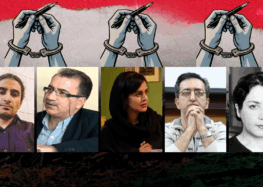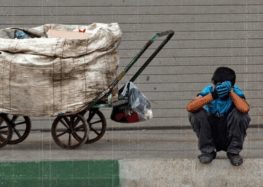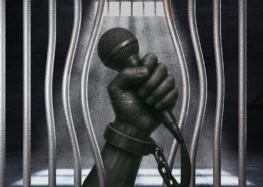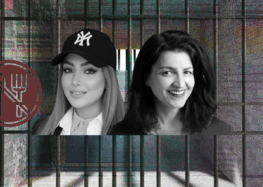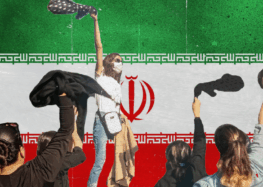Interview: Iranian Photojournalist Recounts State Violence During Woman, Life, Freedom Protests
 Journalists Face Arrest, Torture, Detention to Document Iran’s Lethal Repression
Journalists Face Arrest, Torture, Detention to Document Iran’s Lethal Repression
October 22, 2024 – As we approach the International Day to End Impunity for Crimes Against Journalists, the Center for Human Rights in Iran (CHRI) and Middle East Images (MEI) present an exclusive interview with an Iranian photojournalist who risked his life to document the “Woman, Life, Freedom” movement that erupted across Iran in 2022, following the killing of Mahsa Jina Amini in state custody in Iran days after her arrest for an allegedly improper hijab.
This photojournalist has endured state violence, detention, and surveillance, necessitating the anonymity of his identity for safety reasons. Yet, his powerful images have been shared across global platforms.
“They threatened me, put a weapon to my head, and applied electric shocks, saying, ‘If you don’t give up your phone by the day after tomorrow, it only takes a moment, and we might do it,’” he recounted.
His photographs, captured amidst the chaos of protests, reveal not only the unbreakable courage of Iranians demanding freedom but also what it takes to document the state’s violent repression.
Despite sustaining injuries and facing the constant threat of arrest, this photojournalist continued his work, driven by a profound commitment to amplify the voices of those peacefully fighting for their basic human rights even as they faced threats of violence, arrest, torture, and execution. Through his lens, the story of the “Woman, Life, Freedom” movement lives on, inspiring hope and resilience against tyranny.
“As a journalist over the years… I have shown the realities that exist in society and have always been with the people … I will be with the people until we achieve victory because it is our natural right,” he said.
In Iran, journalists face extreme risks, including arrest, torture, and death for exposing state violence or covering protests. As one of the world’s top ten jailers of journalists, the Iranian government’s crackdown on press freedom makes documenting and reporting on human rights abuses extremely dangerous. As a result, many work anonymously to avoid persecution and are forced to go into exile.
Read the full interview conducted by CHRI and MEI below.
Can you describe the atmosphere in Tehran when the “Woman, Life, Freedom” movement began after the September 2022 death of Mahsa Jina Amini?
From the beginning of the “Woman, Life, Freedom” movement and the news of Jina’s death, the atmosphere in [Tehran] changed drastically. There was chaos in front of Kasra Hospital, and access to Argentinian Street became very difficult due to the traffic. The streets were filled with mothers and daughters gathering in front of the hospital or in the main streets. The scenes that unfolded on Valiasr Street and Keshavarz Boulevard were surreal. I hesitated to take my camera out because of past experiences where taking photos led to arrests. But walking through the streets, I felt I couldn’t ignore what was happening and had to document it, even if it meant risking my life or getting arrested. That night, I went home and told my family that if they didn’t hear from me the next day, they should assume something had happened to me.

Can you share an experience where you faced danger while trying to photograph the protests?
I continued to go out, trying to keep my camera with me, and when it wasn’t possible, I used my phone. At one point, I was very close to being arrested, and the tear gas caused severe shortness of breath. We took refuge in a house, even though plainclothes forces came and fired at the house, beating on the door with a baton and shouting for us to open it. There were 15 of us in that house, including an elderly woman who had come with us without a headscarf. I asked her why she had come alone, and she said, “I came to fight for you.”
After two hours of hiding, we went outside. I saw an elderly woman, about 80 years old, walking without a hijab and with a striking appearance. I remember in the park they were taking everyone away. The next day, I drove from one neighborhood to another, trying to capture images of the protests. I never went alone, so if something happened, others would know.
The following day, the shooting started. My friend got hit, but we quickly got into the car and left. It was a paintball gun. The day after, a few security forces were standing there, the ones dressed in black. We were passing by when suddenly one of them showed his baton and attacked us. We ran and ended up on Enghelab Street. That’s where a few men on motorbikes, dressed as plainclothes officers, started shooting randomly. One of those paintballs hit me in the stomach. The mark is still there. It was incredibly painful, a burning sensation in my abdomen, but I managed to get into an alley before anything else could happen.
The next day, I went back to Enghelab Street. I came out of the metro, and the security forces were harassing a young woman, trying to take her away. There was a mother and daughter wearing chadors. The woman with the hijab intervened to save the girl and got into a confrontation with the security forces.
She turned to them and said, “You are not one of us; you are criminals.” She told the agents, “I wear the hijab for myself, not for your government. You’ve made it so that when people see us on the street, they think we support the regime.” She shouted, “I swear to God, I’m not with them, but I wear the hijab because I believe in God. I believe in…,” and she mentioned the name of one of the religious figures. The security forces then hit the woman wearing the hijab.
It was then I realized this movement is not about people wanting to walk the streets without [certain] clothes. People were fighting for dignity, for a dignified freedom, and that’s why they had taken to the streets.
After a few minutes, I saw a young boy being dragged into the BRT station. Along with a few others who were watching, something sparked between us, and we managed to confront the government forces and rescue the boy. Then we all ran away.
The first thing I could do at the protests was to help and stand by the people and then take photos. That means if, in a moment, something happened to someone—if they were arrested or injured—I wouldn’t take photos; I’d go help because saving a human was much more important to me than capturing that image. No matter what would happen with the photo, even if it became famous or won awards, at that moment, saving a life was much more important to me.
We were on the streets when people came to help pull down a government billboard. The billboard broke, and with the hands of Iran’s youth, that government billboard fell. We dragged it into the middle of the street, blocked the road, and started a fire. That’s when some of the brave girls of our land climbed onto a car and threw off their scarves, tossing them into the fire. I captured that moment because it was daytime, and the phone I had was decent, so I was able to take some good shots. Those images went global.

Can you tell us about the day you were arrested?
The night before [my arrest], I was driving on Valiasr Street, going up from Park Way. We were listening to Shervin’s song [the unofficial anthem of the “Woman, Life, Freedom” protests] with the volume cranked up, honking continuously. That’s when they came and broke my car windows and mirrors. They even marked my car to signal others to arrest me. They marked it with spray paint, but I went into an alley and wiped it off.
The next day, I fixed the windows and mirrors. I was on Hemmat Street, driving back. It was October 11, and there was a group of motorcyclists riding around, smashing the mirrors or windows of anyone who was playing music or honking. I tried not to let them pass, but they came and broke my car window and mirror again.
Then I made a decision: I had to take down these motorcycles. They had gone into the northern part of the school area, and I turned around, accelerating. I sped up to them, and when I got close, I braked sharply at the last moment and slammed into their motorcycles. Several of them fell to the ground. I got out of the car and fought with them, hitting a few of them. The rest of the motorcyclists turned around and attacked me. They beat me so badly that my face and head were injured. They hit my left leg so much with a baton that it broke. I was in a lot of pain.
Then they arrested me. They transferred me to a van, blindfolded me and started interrogating me. They said we were going to see someone else. They drove around the area, and then we got into another car. I was interrogated again. Then we returned to my own car, and another person came into my car and interrogated me.
I was very scared, but I was determined I had done the right thing. The only thing I was afraid of was that my family would get worried. But I kept reminding myself that I had informed my family, and told them if they didn’t hear from me or if I didn’t answer my phone for a few hours, they should know I was arrested. It was around 10 or 11 at night. I peeked from under the blindfold and saw that they had now transferred me to a military base. From under the blindfold, I saw that they had taken me to a base affiliated with the IRGC and located in the area of the IRGC’s roundabout. When we arrived, an old man opened a large door and made me get out of the car.
The interrogations started, and they wanted my phone’s passcode. At first, I refused to give it to them, but I was beaten so badly that I had to give it up. They threatened me, put a weapon to my head, and placed electric shocks on top of my head, saying, “If you don’t give up your phone by the day after tomorrow, it only takes a moment, and we might do it.” I was forced to give up my phone the next day.
The interrogation began, and they presented an inquiry showing my car’s license plate from various locations. They showed pictures of me and said that I was the person in them. They questioned me about the photos and videos they claimed I had taken, I denied taking any of them. There was another round of interrogation and a body search, and then I was taken to a solitary cell where I spent several hours.
Then, I was transferred to another cell, where there was a young boy. While I was resting there, I saw that the boy had become mentally disturbed due to the torment he had endured. Every detail of these events, every second of them, is vivid in my mind. I’m going through it all, and I apologize if it’s lengthy; I want it to be recorded accurately.
What happened there was that they didn’t let us sleep at all. If you lay down, your hands and feet had to be outside the blanket because they were monitoring us with cameras. If your eyes closed and they knew you were about to sleep, they would suddenly make a noise or tell you to stand up and sleep on your feet. I had to stand on my feet for hours to try to sleep, but I couldn’t. In the morning, I was slumped in a corner of the wall, and they woke me up. They interrogated me again, put on blindfolds and handcuffs, and transferred me to Evin Prison, where they interrogated me once more. After that, I went to the prosecutor’s office. From there, I was transferred to Tehran’s Grand Prison.
What was surprising was that those who arrested and interrogated me were people who had well-groomed, styled hair and professional-looking beards, and were well-dressed. Their cologne was noticeable, and their appearances were up-to-date. I thought to myself, if I saw someone like that on the street, I’d think they were one of us and were ordinary people protesting. They were actually undercover agents.
I remember being on Shariati Street, where people were gathering. I became suspicious of someone I saw greeting a few officers. He put on a mask and joined our crowd. I noticed he was filming. I alerted a few people nearby, and we grabbed this person, beat him up, and confronted him about why they were filming. He was an agent, and fled. Five minutes later, a group of motorcyclists started chasing me. After about twenty minutes of running through alleyways, a car door opened, and the driver told me to get in. I was suspicious, so I continued running, but the person insisted, saying they wanted to save me. I got into the car, and was treated well by the driver and his wife. Once the situation calmed down, they took me to another street, where I managed to get to my car.

What was the most memorable event?
The best event was when that woman with a hijab stood up for the girls of our country. The worst was dealing with the people who were disguised as ordinary people. It was difficult for me to accept that these were agents in disguise. It made it hard to trust anyone.
Can you tell us about the challenges you faced after your release?
After I was released, I saw many girls freely wearing what they wanted and being in the streets as the protests continued. It was good to see that people were not regretting their actions, despite the harsh sentences given to them. Everyone who had been in prison and was later freed remained resolute, and their courage was inspiring. However, a personal downside was feeling much more isolated, and I found it challenging to find work or resume photography.
My interrogator told me, “We will make you regret this so that you can’t work anywhere or establish any connections,” and what they said came true. I experienced severe depression, and my body had become very weak; because of bone injuries, I needed surgery as soon as possible, but I had no income, insurance or financial support, which made it very difficult.
Despite all this, I remained determined to resume photography, to return to the streets, to show the realities of society, and to continue fighting against this regime. I had to go into debt, but I lived for survival, for victory, and to show that victory. Even now, I still have that hope, and I’m certain we will achieve it. I am doing everything I can to be there on the day of victory, when I can capture that photo because it is our right. We, the people, have the right to be free and to think about victory in our fight against this regime, and I hope that day comes soon.

Are you hopeful about the future of Iran?
Yes, I am very hopeful about the future of Iran. I hope that sooner or later, we will reach our goal. It is difficult but achievable. I believe this will happen because in prison, I saw that when I asked everyone, they all said they weren’t regretful. They said we’ll get out, continue, and become more determined and stronger because we have seen the end of the Islamic Republic.
The end of the Islamic Republic is either to throw you in prison, kill you, or prevent you from working and pressure your family. I have seen the threats to my family and friends, my arrest and imprisonment. In prison, I was taken to the brink of being charged with rebellion, and they wanted to give me a death sentence. But I fight for victory, for achieving the natural right of freedom that is truly a fundamental right and that the Islamic Republic has taken from us.
Victory will happen whether we are here or not. Our actions will help because we took a step in this path, in this struggle. Those who were active in previous years, all of them have a share in this victory. Those who are here now, those who are not, those who have been killed, or those who are in prison, all of them have taken a step toward the destruction of this regime and have all made an effort. I hope that this happens soon so that I can see it and witness it.
As a journalist, I have always been on the side of truth. I have shown the realities that exist in society and have always been with the people. I will be with the people until we achieve victory. Our lives were destroyed, our youth was lost, but we are fighting for the future of Iran, for the future of our children, and for the future of our families, and we will achieve it.

Was the regime’s campaign of repression and crackdown successful?
No, because if it had been successful, it would have managed to suppress everything. After 1988, nothing would have happened; after 2017, 2019, and 2022, nothing would have happened. But it did, and it will definitely happen again.
The “Women, Life, Freedom” protests will rise again. The people will return to the streets. This regime is stuck in the quagmire it has created. If the regime had been successful, I, who went to prison, was beaten, and was almost taken to the gallows, should have stopped participating in these protests and abandoned any activism. But I am now even more determined to fight.
I told the judge … you will sit in the dock as the accused and will have to answer for what you have done and the future you are destroying. This regime … will have to answer for the devastation it has brought upon the country. They have destroyed the youth, the resources, and the hopes and dreams of the people. It was then that he said, “Get out, you are going to the grave,” but I am convinced in my heart that this regime will one day have to defend itself in a fair court, and it will have no defense.
This report was made possible from donations by readers like you. Help us continue our mission by making a tax-deductible donation.

